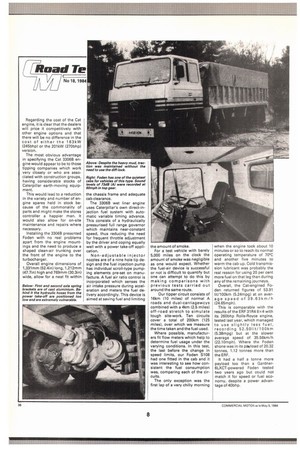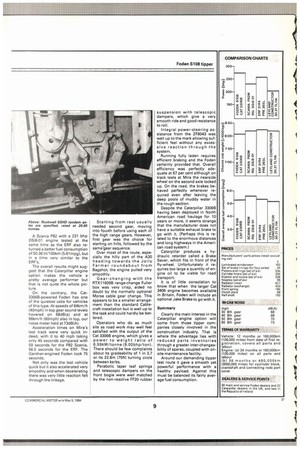Pillar of strength
Page 115

Page 116

Page 117

If you've noticed an error in this article please click here to report it so we can fix it.
By taking the American Caterpillar engine for its S108, Foden has come up with a steady workhorse that those working in the building industry will find valuable, if a little on the thirsty side WHEN FODEN TRUCKS first served notice of its intention to add the Caterpillar engine to its list of power options (CM September 3, 13831 it was clearly seen as a move towards strengthening Foden's long established relationship with the UK tipping and construction industry.
The 3306 engine is the most commonly used power unit in Caterpillar's range of earthmoving machines and many construction company service engineers are certainly familiar with it.
But what advantage will the Cat option offer to tipper fleet operators over the well-established engines already on the market? Foden points to the fact that the Caterpillar 3306 is not only plant oriented but has also enjoyed a healthy reputation in America over the past 10 years in both Kenworth and Peterbilt road haulage vehicles, particularly in tanker and bulk carrier applications.
Reliability and longevity is another of its claims, with 3306B engines carrying 300,000 miles warranties on the block, crankshaft and connecting rods — terms very similar to those offered by many existing engine manufacturers such as Cummins, Gardner or Rolls-Royce.
Since the beginning of this year, Foden Trucks has ceased to disclose actual retail prices of its new vehicles, leaving it instead to its dealers who will only quote approximate prices initially.
Regarding the cost of the Cat engine, it is clear that the dealers will price it competitively with other engine options and that there will be no difference in the cost of either the 183kW 1245bhp) or the 201kW (270bhp) version, The most obvious advantage in specifying the Cat 3306B engine would appear to be to those tipping companies which work very closely or who are associated with construction groups, having considerable stocks of Caterpillar earth-moving equipment, This would lead to a reduction in the variety and number of engine spares held in stock because of the commonality of parts and might make the stores controller a happier man. It would also allow for on-site maintenance and repairs where necessary.
Installing the 33066 presented Foden with no real problems apart from the engine mountings and the need to produce a shaped clean-air trunking over the front of the engine to the turbocharger.
Overall engine dimensions of 1,331mm (52.4in) long, 1,212mm (47.7in) high and 769mm (30.3in) wide, allow for a neat fit within the chassis frame and adequate cab clearance.
The 3306B wet liner engine uses Caterpillar's own direct-injection fuel system with automatic variable timing advance, This consists of a hydraulically pressurised full range governor which maintains near-constant speed, thus reducing the need for frequent throttle adjustment by the driver and coping equally well with a power take-off application.
Non-adjustable injector nozzles are of a nine hole tip design and the fuel injection pump has individual scroll-type pumping elements pre-set on manufacture. A fuel air ratio control is incorporated which senses the air intake pressure during acceleration and meters the fuel delivery accordingly. This device is aimed at saving fuel and limiting
he amount of smoke, For a test vehicle with barely 5,000 miles on the clock the amount of smoke was negligible as one would expect. Whether the fuel-air device is successful or not is difficult to quantify but one can attempt to do this by making comparisons with previous tests carried out around the same route.
Our tipper circuit consists of 16km 110 miles) of normal A roads and dual-carriagewcys combined with a 4km (2.5 miles) off-road stretch to simulate tough site-work, Ten circuits cover a total of 200km (126 miles), over which we measure the time taken and the fuel used.
Where possible, manufacturers fit flow meters which help to determine fuel usage under the varying conditions. in this test, the last before the change in speed limits, our Foden 8108 had one fitted in the cab and it was interesting to see how consistent the fuel consumption was, comparing each of the circuits.
The only exception was the first lap of a very chilly morning when the engine took about 10 minutes or so to reach its normal operating temperature of 70°C and another five minutes to warm the cab up. Cold transmission lubricant was probably the real reason for using 20 per cent more fuel on that leg than during any of the remaining journeys.
Overall, the Cat-engined Foden returned figures of 53,91 litrtOOkm (524mpg) at an average speed of 39.63 km/h (24.65mph).
This is comparable with the results of the ERF 31R4 8x4 with its 260bhp Rolls-Royce engine, tested last year which managed to use slightly less fuel, recording 52.501it/100km (5.38mpg) but at the slower average speed of 35.56km/h (22.10mph). Where the Foden shone was in its paiyload of 20.32 tonnes, 1.12 tonnes more than the ERF.
It had a half a tonne more payload too than a Gardner6LXCT-powered Foden tested two years ago but could not match it for speed or fuel economy, despite a power advantage of 40bhp. A Scania P82 with a 231 bhp 0518-01 engine tested at the same time as the ERF also returned a better fuel consumption 01 50.36 111/100km (5.61mpg), but in a time very similar to the ER F's.
The overall results might suggest that the Caterpillar engine option makes the vehicle a pretty average performer but that is not quite the whole picture.
On the contrary, the Cat33066-powered Foden has one of the quietest cabs for vehicles of this type. At speeds of 64km/h (40mph) in top gear sound levels hovered on 68d6(a) and at 96km/h (60mph) also in top, our noise meter held at 73d6(A).
Acceleration times on Mira's test track were very quick indeed, with 0 to 40 mph taking only 45 seconds compared with 59 seconds for the P82 Scania, 56.5 seconds for the ERF. The Gardner-engined Foden took 75 seconds.
Not only was the test vehicle quick but it also accelerated very smoothly and when decelerating there was very little reaction felt through the linkage. Starting from rest usually needed second gear, moving into foudh before using each of the high range gears. However, first gear was the choice for starting on hills, followed by the same'gear sequence, Over most of the route, especially the hilly part of the A30 heading towards the Jolly Farmer roundabout from Bagshot, the engine pulled very smoothly.
Gear-changing with the RTX11609B range-change Fuller box was very crisp, aided no doubt by the normally optional Morse cable gear change. This appears to be a smaller arrangement than the standard Cablecraft installation but is well up to the task and could hardly be bettered.
Operators who do as much site as road work may well feel satisfied with the output of the Cat 330613 engine, which gives a power to weight ratio of 6.59kW/tonne (9.00bhp/tonl. There should be few complaints about its gradeability of 1 in 3.7 or its 22.8m 175ft1 turning circle between kerbs.
Parabolic taper leaf springs and telescopic dampers on the front bogie were well matched by the non-reactive FF20 rubber suspension with telescopic dampers, which give a very smooth ride and good resistance to roll.
Integral power-steering assistance from the ZE8043 was well up to the mark allowing sufficient feel without any excessive reaction through the system.
Running fully laden requires efficient braking and the Foden certainly provided that. Overall efficiency was perfectly adequate at 67 per cent although on track tests at Mira the nearside wheel on the second axle locked up. On the road, the brakes behaved perfectly whenever required even after leaving the deep pools of muddy water in the rough section.
Despite the Caterpillar 33068 having been deployed in North American road haulage for 10 years or more, it seams strange that the manufacturer does not have a suitable exhaust brake to go with it. (Perhaps this is related to the enormous distances and long highways in the American road system.) Caterpillar produces a hydraulic retarder called a Brake Saver, which fits in front of the fly-wheel. Unfortunately it requires too large a quantity of engine oil to be viable for road transport.
It is of little consolation to know that when the larger Cat 3406 engine becomes available in Britain, Foden will include an optional Jake Brake to go with it.
Summary Clearly the main interest in the Caterpillar engine option will come from those tipper companies closely involved in the construction industry, That is where the advantage lies with reduced parts inventories through a greater inter-changeability of spares, coupled with onsite maintenance facility.
Around our demanding tipper test route it gave a smooth yet powerful performance with a healthy payload. Against this must be balanced its fairly average fuel consumption.












































































































































